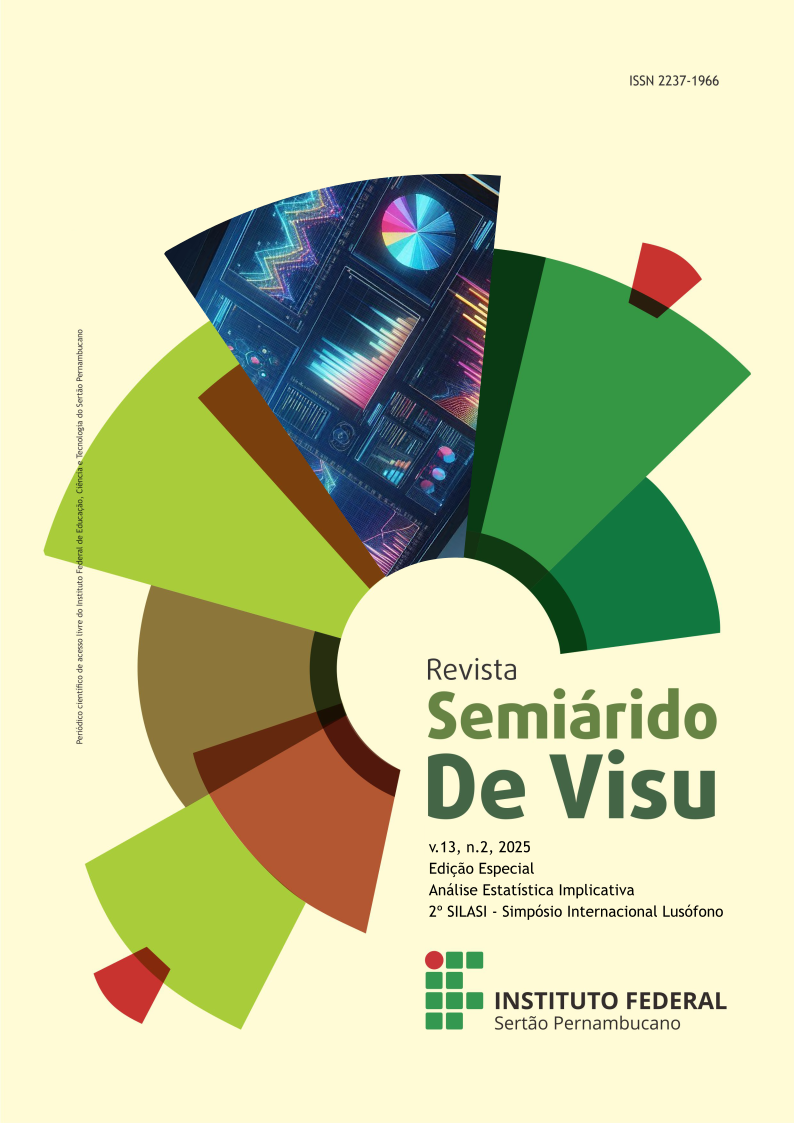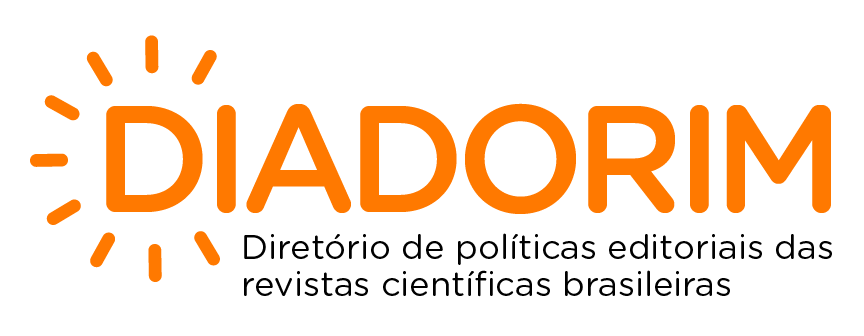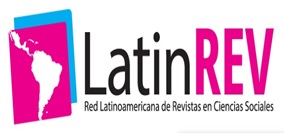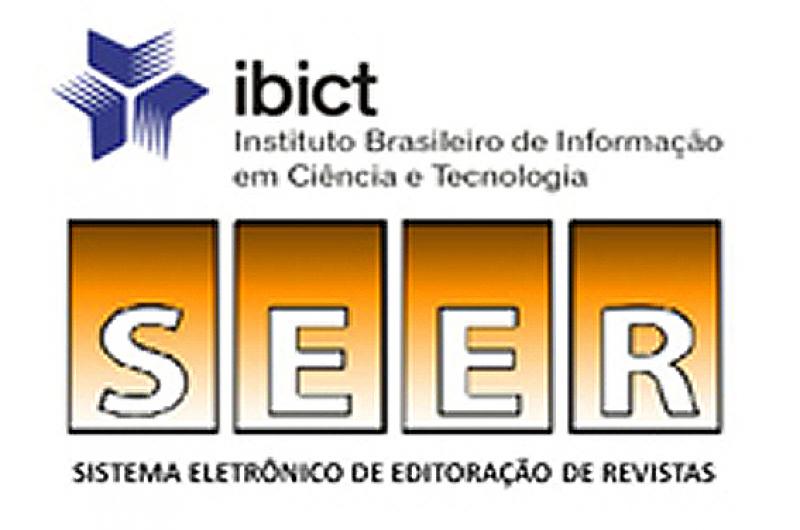Utilización de ASI para analizar el rendimiento de los estudiantes de secundaria en Estadística
Visualizações: 461DOI:
https://doi.org/10.31416/rsdv.v13i2.1121Palabras clave:
Análisis estadístico implicativo; Media aritmética; Desviación estándarResumen
El objetivo de este estudio es investigar si los alumnos de tercer año de enseñanza media de una escuela estatal de Pernambuco comprenden los conceptos de media aritmética y desviación estándar, así como el algoritmo necesario para calcular estas medidas. Para ello, aplicamos un cuestionario compuesto por 10 situaciones problemáticas que involucraban algoritmos e interpretaciones de los conceptos de las medidas en cuestión. Para analizar los datos, se creó una hoja de cálculo de Microsoft Office Excel que se sometió a un tratamiento cuya lógica es la asignación de relaciones entre los datos representados por los dígitos binarios 0 y 1 que indican la ausencia o presencia de un evento. Las variables analizadas se describieron según el número de preguntas, si el alumno acertó, se equivocó o no contestó. Los datos de la hoja de cálculo se analizaron posteriormente utilizando el software CHIC (Hierarchical, Implicative and Cohesive Classification) versión 7.0, en el que generamos gráficos implicativos. Tras analizar los datos, pudimos comprobar que la mayoría de los alumnos eran capaces de responder a las preguntas relacionadas con el algoritmo de la media aritmética, pero tenían dificultades para interpretar algunos de los conceptos relacionados con esta medida. En cuanto a la desviación típica, los alumnos tuvieron dificultades para construir el algoritmo, pero mostraron mejores resultados al responder a las preguntas relacionadas con su concepto.
Citas
ANDRADE, V. L. V. X.; RÉGNIER, J.-C. Problems and challenges in teacher training of mathematics students with a view to preparing them to teach statistics in basic education. In: International Congress of Mathematics, Engineering and Society - ICMES2009, 1., Dec 2009, Curitiba, Brasil. p. 1-9. ICMES2009-19. Disponível em: https://shs.hal.science/halshs-00506493v1. Acesso em: 3 de maio de 2024.
BATANERO, C. Significado y comprensión de las medidas de posición central. Uno: Revista de Didáctica de las Matemáticas, n. 25, p. 41-58, 2000.
BAYER, A.; BITTENCOURT, H.; ROCHA, J.; ECHEVESTE S. A Estatística e sua história. Canoas, 2009. Disponível em: https://notasdeaula.files.wordpress.com/2009/08/estatistica-e-sua-historia.pdf. Acesso em: 10 de julho de 2024.
BEN-ZVI, D.; GARFIELD, J. Statistical literacy, reasoning, and thinking: Goals, definitions, and challenges. The challenge of developing statistical literacy, reasoning, and thinking. p. 03-15, Dordrecht, The Netherlands: Kluwer Academic Publishers, 2004, p. 3-15.
BIANCHINI, B. L.; LIMA, G. L. de (Orgs.). O pensamento matemático e os diferentes modos de pensar que o constituem. 1. ed. São Paulo: Editora Livraria da Física, 2023. 575 p. ISBN 9786555633665
BRASIL. Ministério da Educação. Base nacional comum curricular. Brasília, DF: MEC, 2017. Disponível em: http://basenacionalcomum.mec.gov.br/images/BNCC_EI_EF_110518_versaofinal_site.pdf. Acesso em 16 jul. 2024.
CAI, J. Beyond the Computational Algorithm: Students’ understanding of arithmetic average concept. Proceedings of the 19h International Conference for the Phychology of Mathematics Education, vol.3, p. 144-151. Recife, Permambuco, 1995.
CAMPOS, C. R. A educação estatística: uma investigação acerca dos aspectos relevantes à didática da estatística em cursos de graduação. 2007. Tese (Doutorado em Educação Matemática) – Universidade Estadual Paulista, Rio Claro, 2007
CASTANHEIRA, N. Estatística aplicada a todos os níveis. 2. ed. São Paulo: Editora Acadêmica, 2013.
CAZORLA, I. M. A relação entre a habilidade viso-pictórica e o domínio de conceitos estatísticos na leitura de gráficos. 2002. Tese (Doutorado em Educação) – Universidade Estadual de Campinas, Faculdade de Educação, Campinas, SP, 2002. Disponível em: https://hdl.handle.net/20.500.12733/1592398. Acesso em: 27 jul. 2024.
CAZORLA, I. M.; Santana, E. R. dos S. Tratamento da Informação para o Ensino Fundamental e Médio. 1. ed. Itabuna: Via Litterarum, 2006.
GAL, I. Adult’s statistical literacy: meanings, components, responsabilities. International Statistical Review, v. 70, n. 1, p. 1-25, Netherlands, 2002.
GARFIELD, J. The challenge of developing statistical reasoning. Journal of Statistics Education, v. 10, n. 3, 2002. Disponível em: https://www.tandfonline.com/doi/epdf/10.1080/10691898.2002.11910676?needAccess=true. Acesso em: 10 maio 2024.
GRAS, R.; REGNIER, J.-C.; GUILLET, F. Analyse Statistique Implicative: Une méthode d'analyse de données pour la recherche de causalités. Cépaduès Éditions, Toulouse, 2009.
HUILLCA, J. R. A.; CRUZ, G. V. C. Uso del geogebra en el aprendizaje de las medidas de tendencia central en estudiantes del segundo grado de educación secundaria de la institución educativa mixta fortunato L. Herrera. Tese – Universidad Nacional de San Antonio Abad Del Cusco, Facultad de Educación y Ciencias de la Comunicación, Cusco, 2018. Disponível em: http://hdl.handle.net/20.500.12918/5535. Acesso em: 27 jul. 2024.
JUCÁ, R. de S. Uma sequência didática para o ensino das operações com os números decimais. 2008. 116 f. Dissertação (Mestrado) – Universidade do Estado do Pará, Belém, PA, 2008. Disponível em: https://oasisbr.ibict.br. Acesso em: 20 jul. 2024
LOPES, C. E. O ensino da estatística e da probabilidade na educação básica e a formação dos professores. Cadernos CEDES, v. 28, p. 57-73, jan.-abr. 2008. Disponível em: https://doi.org/10.1590/S0101-32622008000100005. Acesso em: 28 jul. 2024.
LOPES, P.C., FERNANDES, E. Literacia, Raciocínio e Pensamento Estatístico com Robots. Quadrante, v. 23, n. 2, p. 69–94, 2019. Disponível em: https://doi.org/10.48489/quadrante.22907. Acesso em: 25 jul. 2024
LUNA, L. C. De; CARVALHO, J. I. F. de. Oi, quem está olhando minhas estatísticas? – Uma discussão do desempenho de estudantes da Educação Básica sobre média aritmética. Revista de Educação em Ciências e Matemática, v.15, n. 33, Jan-Jun 2019. p.151-166. Amazônia, 2019. Disponível em: http://dx.doi.org/10.18542/amazrecm.v15i33.6116. Acesso em: 16 jul. 2024.
PAES, A. T. Por dentro da estatística. Einstein: Educação continuada em saúde, São Paulo, v. 6, p. 107-108, 2008.
SCHREIBER, K. P. et al. Níveis de compreensão do conceito de média aritmética de adolescentes a partir do Método Clínico-Crítico Piagetiano. Bolema, Rio Claro, SP, v. 33, n. 64, p. 491-512, ago. 2019. Disponível em: https://doi.org/10.1590/1980-4415v33n64a03. Acesso em: 15 jul. 2024.
SILVA, C. B., Pensamento estatístico e raciocínio sobre variação: um estudo com professores de matemática. Tese (doutorado em educação matemática) - Pontifícia Universidade Católica de São Paulo, São Paulo, 2007. Disponível em: https://tede2.pucsp.br/handle/handle/11206. Acesso em: 05 jul. 2024.
TRIOLA, M.F. Introdução à Estatística. 11. ed. Rio de Janeiro. Editora LTC, 2014.
Descargas
Publicado
Cómo citar
Número
Sección
Licencia
Derechos de autor 2025 Revista Semiárido De Visu

Esta obra está bajo una licencia internacional Creative Commons Atribución 4.0.















